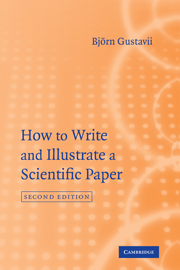Book contents
- Frontmatter
- Contents
- Preface
- Acknowledgments
- 1 Basic rules of writing
- 2 Comments on scientific language
- 3 Drafting the manuscript
- 4 Choosing a journal
- 5 Preparing a graph
- 6 Drawings
- 7 Figure legends
- 8 How to design tables
- 9 Title
- 10 Authors
- 11 Abstract
- 12 Introduction
- 13 Methods
- 14 Results
- 15 Discussion
- 16 Acknowledgments
- 17 References
- 18 Ph.D. and other doctoral theses
- 19 Letters and case reports
- 20 Numbers
- 21 Abbreviations
- 22 How to present statistical results
- 23 Typing
- 24 Dealing with editors and referees
- 25 Correcting proofs
- 26 Authors‘ responsibilities
- Literature needed on your desk
- Further reading
- Literature cited
- Index
15 - Discussion
Published online by Cambridge University Press: 05 June 2012
- Frontmatter
- Contents
- Preface
- Acknowledgments
- 1 Basic rules of writing
- 2 Comments on scientific language
- 3 Drafting the manuscript
- 4 Choosing a journal
- 5 Preparing a graph
- 6 Drawings
- 7 Figure legends
- 8 How to design tables
- 9 Title
- 10 Authors
- 11 Abstract
- 12 Introduction
- 13 Methods
- 14 Results
- 15 Discussion
- 16 Acknowledgments
- 17 References
- 18 Ph.D. and other doctoral theses
- 19 Letters and case reports
- 20 Numbers
- 21 Abbreviations
- 22 How to present statistical results
- 23 Typing
- 24 Dealing with editors and referees
- 25 Correcting proofs
- 26 Authors‘ responsibilities
- Literature needed on your desk
- Further reading
- Literature cited
- Index
Summary
Toward the end of World War II, General Patton advanced with his tanks through the enemy lines. From motorcycle dispatch riders he received intelligence reports from other parts of the front. When a rider began reading out the dispatch from the very beginning, Patton most often asked him to go directly to the bottom line.
In the same way, hurried readers of scientific papers thumb through the pages to find the final paragraph of the discussion. Why? Apparently, because that is where the reader can usually get a comprehensive conclusion of the results.
But there is no generally accepted form on how to arrange the various parts leading up to the conclusion. So to help you I have chosen, as a model, an especially well-designed discussion in a paper by Logan et al(1993). Based on this I have composed a structure for the discussion section that can be used as a guide when writing this section. It has four parts: Main message, Critical assessment, Comparison with other studies, and Conclusions Let us discuss them step by step.
(1) Main message, which answers the question posed in the introduction section and includes the main supporting evidence.
Most often, however, the opening paragraph of a discussion unnecessarily recapitulates in detail what the readers have already been told twice, once in the abstract and again in the results section, as in the following example. (Imagine General Patton listening to this!)
- Type
- Chapter
- Information
- How to Write and Illustrate a Scientific Paper , pp. 74 - 78Publisher: Cambridge University PressPrint publication year: 2008



